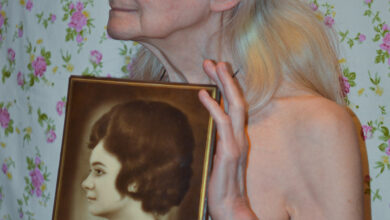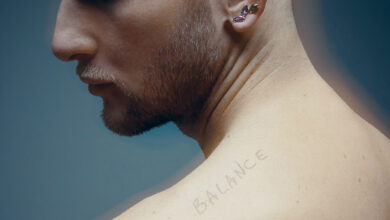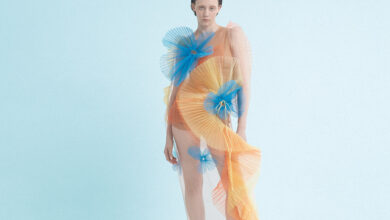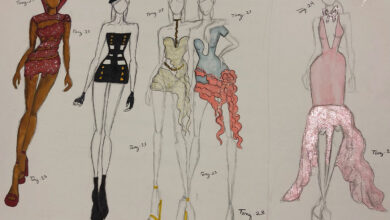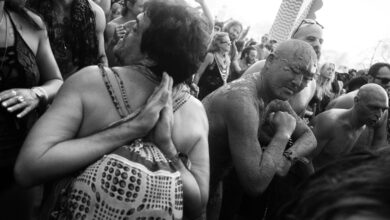Ukraine callingZoot Sees
Anna Moskalets, painter, collage artist and independent curator
"Through the prism of the magic of ancestral memory"

Connecting with Ukrainian artist Anna Moskalets via video call, you might not guess she has been spending long days and nights in her studio. Fresh-faced and articulate in her non-native English, Anna speaks thoughtfully about her work and adjusting to a new version of life she was not planning for but is nonetheless thriving in. With art shows coming up in the US in LA and Atlanta to raise money for Ukraine, Anna has been hard at work creating a series of paintings and digital collages speaking to modern womanhood, ancestral memory and the war waging in her country. ZOOT spoke with Anna about her artwork, where she finds inspiration and how Russia’s war in Ukraine has upended her life.
Words and interview by Michaela Doyle and Guido Avelino
Artwork by Anna Moskalets
Born in the northeast of Ukraine, Anna, like many other Ukrainians, fled her home country in search of peace and security. Now, as we approach one year since Russia began its invasion in Ukraine, Anna is living in Germany – going from Berlin to now Potsdam – where she found a studio and place to temporarily call home. “Potsdam is a balance between peaceful, calm life and city life.” But she is constantly returning to her true home in Ukraine through her artwork.
A persistent theme in Anna’s artwork today is women draped in scarves. For Anna and many Ukrainians, scarves are a multifaceted part of their cultural heritage. She explains, “in Ukrainian culture, it’s not just a piece of material. It’s something that you can see on children’s heads, on grandmothers and women. When you see it on different generations, it gathers them all in one.” The colours and ways of wearing the scarves on the head and body signal different life events and situations that can be tragic or celebratory. “It’s not just something simple; it brings a lot of meaning, you just need to know this kind of culture to understand all the pitfalls that it can bring.”

The women in Anna’s paintings have a haunting yet familiar quality to them. In fact, the models Anna uses for the cloaked silhouettes are typically friends or family members—someone with whom she has a previous connection. “It is the will of the [viewer] to imagine what she wants, but for me, I’m close to the person. I feel a connection with what I’ve made”, she explains. Through the process of covering them, arranging the fabric and photographing them in preparation to paint, the artwork becomes a collaboration and an act of love.
Anna started her series with the scarves in 2019, but she began to see the imagery in a different way when the war started. After fleeing her home and her studio in Kyiv, one way she found to express herself in the gloom and terror of the basement where she was hiding was by exploring digital collages that incorporate the cloaked women in her oil paintings. “It saved me and it saved a lot of money for therapy because I was in a basement and I was trembling and felt really scared. I realized I needed to do something and then the digital collages were the only way to do things.”

The vibrant colours of the painted scarves set against images of buildings leveled by Russian missiles, is a play of contrasts: sublime and disturbing. Seeing these artifacts of Ukrainian cultural heritage juxtaposed against the real present destruction of Ukrainian daily life sends a powerful message. The collages give her a way to react to the war outwardly and in real time.
The photos she uses for the backgrounds are mostly open source, with some coming from her friends on the front lines, and she always chooses them with careful consideration. She is wary of causing emotional harm to her viewers, but still she wants to be impactful in her visual statements. It is “an investigation of life”, as Anna puts it: “horrifying and realistic at the same time”.

Anna’s digital work came as a way for her to extend her expression of self through new mediums and analysis of her surroundings. She realized that the approach would be the most effective way to express her artistic identity. “I tried to visualize liquidity. I tried to visualize streets, and street-like geometrical forms… then I realized I needed something that is really close to my inner vision for what I would like to show to the observer, something that represents my artwork. They will see that it’s my identity.”
One particularly powerful digital collage Anna completed recently is based on her original artwork “Eksteza”. The collage features a woman enveloped in a faded black scarf with her head tilted toward the sky and the hints of a grieving face outlined beneath the covering. The painted woman is superimposed on an image of the residential block in Dnipro that was hit by a Russian missile on 14 January 2023, placed in the gaping hole with disfigured apartments on either side and a mass of crumbled concrete, dust and burned cars below. The friend who modeled for this image had experienced the destruction of her own house only a few months earlier in Lozova. Anna explained, “I chose the silhouette of my friend who lost her home. She has deep grief and understanding because now Ukraine is a big wound that is bleeding. The tragedy of the war touches every Ukrainian.” She explained further, “the frustration is immeasurable. It hurts every time.”



Through her artwork, Anna is raising awareness about the war in Ukraine and money for the army and citizens. She is working closely with the Sunflower Network, a nonprofit organization that raises money for humanitarian aid and automobiles for the Ukrainian Army, having already donated more than $1 million dollars. “I’m happy that we have this kind of collaboration because even though I want to go home and wanna see Ukraine win, you know there are organizations like Sunflower Network that help a lot, which is also great.” Anna’s artwork was recently featured at the Sunflower Network’s Sonya gallery event in LA.
—
Obscured by the sumptuous fabrics, the women in Anna’s oil paintings and collages appear simultaneously restricted and commanding. They defiantly take up space in front of painted tapestries and amongst the rubble, and every veiled face holds a personal history and an entire life of joy and heartache. In the context of Ukrainian cultural heritage or senseless destruction from missiles and bombs, the feminine spirit is vital: “The one that knows no limitations and has the courage to reveal its own essence, live the natural cycle, and perceive the world as it is.”
Below are excerpts from ZOOT’s conversation with Anna.

ZOOT Magazine: Where does your inspiration come from? And has your source of inspiration changed since the war started?
Anna Moskalets: From my personal point of view, inspiration is sporadic. Of course, there are certain people, activities, and situations that fuel my muse better but it does not work day by day and I have to push myself through when finding inspiration can seem frustrating. But it pays off. So I dare to say that regardless of my internal state, I have formed a habit to create work no matter what; and ironically but honestly, it also can be inspiring.
As the war started I found the peaceful effect of escaping into the art process, so it’s even easier now to get inspired by usual states as it became equal to internal peace.

ZOOT: You’ve been doing a lot of collages with photos and paintings. What drew you to fuse your painting with photographs of the war? And what do you feel the collage medium can do that other approaches can’t?
AM: I am really into collages, it brings me a lot of ideas in the process. When the war started I had no possibility to [work] in my studio as it’s located on the 10th floor in Kyiv center so I did not have access to my oil painting process. Also, I was spending a lot of time in the basement during missile shooting, and during that time I realized that I have to do something not to be more concentrated on the sounds outside. So I took my laptop and started making collages with photos and artwork. It was just a natural reflection of what was going on around and for me; it was a symbol of the fact that now my life is not like it was before, and as my life is changed, my artworks are also changed. It helped me in many ways to be honest.


ZOOT: Can you talk a bit about your transition from painting abstract forms to painting human silhouettes covered almost entirely with fabric? What does the new focus mean to you, and what does the fabric represent?
I’ve always been in search of something that would be intimate for me and an honest forward audience so I was experimenting with different forms and states, with the flow of time I came to the series “Grandma’s Handkerchief” – silhouettes covered almost entirely with fabric. In Ukraine, a scarf is a symbol of deep femininity, an attribute of household magic, and a sign of belonging to a family. A square piece of material was used at the birth of a child and as a talisman for loved ones. At the same time, it covered the girl’s hair until she turned into a woman: the colors and the way of wearing changed depending on the situations along the way.
The headscarf is the personification of many generations of women’s experiences. Wise and dark knowledge about the inseparability of life and death. A charm that hides information about the secret part of the soul – the wild woman – is stored inside.

“Grandmother’s Handkerchief” is a demonstration of the existence of a modern woman through the prism of the magic of ancestral memory. The series consists of artworks, where each picture is a chthonic image, one of the manifestations of a wild woman. The one that knows no limitations and has the courage to reveal its own essence, live the natural cycle, and perceive the world as it is. During the creation of images, I used real handkerchiefs of my grandmother, which enhances the authentic energy of the paintings.
In almost all the works, faces and bodies are hidden under large scarves. So specific features do not prevent from seeing the true essence. The ancient soul of the wild woman speaks through the interplay of colors and sensual patterns. “Grandmother’s handkerchief” is not a static decoration, it changes, dies, and is reborn, adds consciousness to itself, and plays with the male part of the female inner world. However, the magical colors of “Grandmother’s Shawl” can disappear under the pressure of the fear of experiencing one’s own wild woman or other circumstances.

ZOOT: What is the inspiration for the patterns and prints seen in your artwork?
AM: In my artworks I use my grandmother’s headscarves prints or just one-colored fabric, it depends on the plot of the painting and the sense.
ZOOT: How do you use your art to showcase and criticize important political and cultural topics?
AM: I’ve always wanted to show something very intimate but important for every Ukrainian citizen. To be honest, I’m not really a fan of straightforward plots in artwork, as I like when the observer can proceed with the dialogue with the artwork, but war is not a place of giving hints: sometimes it’s more important to call for the immediate reaction.

ZOOT: How do you think art can help people find relief during difficult times and traumatic events – like the war right now?
AM: Art can heal, and it’s not just a pretentious phrase. At the moment when I was creating my artworks, it was my personal artistic way to mourn for those who were suffering more times than me. In other words, my art is a conduit for my personal reflection on terror and grief. My emotions were flown outward and I felt relief every time.

ZOOT: Can you tell us about your experience of the early days of the war? Where were you when it started?
AM: The first day of the war caught me in the heart of my motherland: Kyiv. Of course, there were some rumors about war but no one believed it as it was something that you cannot be prepared for, so the phrase “the war is impossible in Europe in the 21st century” was a kind of protective reaction. On the 23rd of February, I decided to stay at the studio for the night as on the morning of the 24th I wanted to finish the latest oil painting, and around 4 am the next day I woke up from the muffled sounds of explosions and the feeling that the house was shaking.
It was a fear that I never experienced because I understood that the “terrible” had begun. After checking the channels in one of the messengers, I saw that people were writing about explosions in different cities in Ukraine. I called a taxi to get home, I was surprised that the city was empty, and music was playing loudly inside the car, the taxi driver behaved calmly and it seemed to me that because of the volume he might not have heard the explosions and I decided not to tell him what happened; the illusion of a peaceful life at that moment seemed sacred.
Arriving home, I called my parents – they live in one of the regions bordering Russia, but in a small village, which at that moment seemed to be a fairly safe place. My father couldn’t believe it, he thought I was delirious. I wish I was delirious, to be honest, but no.
Since then, the life of me and my family has been reduced to calls to check whether everyone is safe. I wouldn’t wish this on my enemy.
Of the unusual roles in which I managed to visit during the 63 days of the war in Kyiv: volunteering, organizing logistics, sending the necessary things for territorial defense and the military.


ZOOT: How have you been supporting your country from Germany?
AM: I moved to Germany to be useful and productive. Both of these points are aimed to benefit my Motherland, since from the very beginning I participate in charity exhibitions, make speeches on the topic of popularizing information about the war from a person who has experienced a lack of food, medicine, blackout, howling sirens, explosions a few hundred meters from home during wartimes.


ZOOT: How are your family and friends and your artistic community still in Ukraine doing?
AM: My family stayed in Ukraine because they do not even imagine life outside Ukrainian borders. I am the most flexible family member in terms of adapting to life in other countries, especially compared to my grandmother who is almost 85 years old and she still remembers the 2nd World War. I feel very sad that she has to survive the war the 2nd time—it’s heartbreaking. But I understand and accept their position to stay at the home of my family, and it definitely deserves respect. Of course, I am extremely worried, every free minute comes down to checking the news and air alerts for Ukraine. When I call my mother, she is always doing well, even when it’s not good. Mothers are such mothers. I am very proud that my family and friends do their best in wartime and try, in addition to their personal lives, to also be participants in the life of the country. The life of my colleagues from the art sphere is very affected by the war; it’s hard for them in Ukraine but they don’t complain, they actively work during breaks with the bombing. Some have lost relatives, homes, but they stay very strong and keep faith in the best. I could only dream of such an environment!


ZOOT: Is there anything that has been a source of levity or comfort for you since the war started?
AM: I love music very much and cannot imagine my life without it, but even this, it seemed that an integral part of my life stopped for a month after the start of the war – I was in such shock and grief that I could not emotionally endure music, many compositions became empty, as if the meaning was lost, because against the backdrop of grief of this magnitude, many things that are sung about in songs seem to be something that is not so important as it seemed before. My joy under the shelling was art: a creative process that mesmerized me with calmness and photos from a past life—until February 24th. Now I can again listen to music, but the photos before the 24th seem to be something very distant, as if from a past life. It’s like a time machine.

ZOOT: Has there been a moment over the past year when you felt most proud to be a Ukrainian?
AM: I have always been proud of my roots, my nationality, so I carried this in my art. I never pursued something mainstream, I wanted to show “our native”, but I will not dissemble. The war showed that Ukrainians are incredibly proud, kind and courageous people who proved this not in word, but in deed. It always brings tears to my eyes from the realization of the power of our national code.

ZOOT: How do you think the rest of the world can best help and support Ukraine?
AM: The best support at this stage is not to forget about the War and the fact that people are dying. Whoever does not want to fight for Ukraine, let them fight for humanity, democracy and freedom, which have been so propagated all over the world all the time. Now Ukraine is the capital of these concepts; only its price is very high—much higher than the increase in gas or food prices—and I would like people to remember and respect this. And, of course, now there are many funds to help the army, refugees, orphans, nurseries, so everyone can contribute.
ZOOT: What do you imagine your life will be like when the war is over? What’s the first thing you will do then?
AM: I will go home to my family.

ANNA MOSKALETS @anna_moskaletz
Upcoming shows:
16 – 24 February 2023
SONYA Pop-up gallery “Art for Ukrainian aid”
A Sunflower Network Project @sunflower.network.io
www.sunflowernetwork.io
In partnership with Art Territory @art.territory.ua
www.art-territory.com
At The Pavilion at Century Park
2000 Avenue of the Stars
Los Angeles, CA, USA
Wednesday – Friday, 10:00am – 6:00pm
25 February 2023
3:00pm – 6:00pm
“Art of Resistance: Love. Freedom. Ukraine.”
A pop-up charity event including exhibition and auction
Organised by Art Territory @art.territory.ua
www.art-territory.com
In partnership with Stand With Ukraine Foundation
Helms Design Center at Helms Bakery District
8745 Washington Blvd
Culver City, CA, USA
4 March 2023
3:00pm – 7:00pm
“Ukrainian Art. Path of Resistance”
A pop-up charity event including exhibition
Organised by Tirone & Weaver Team, Ansley Real Estate
n partnership with Art Territory @art.territory.ua
www.art-territory.com
31 Church Street
Alpharetta, Atlanta, GA, USA


